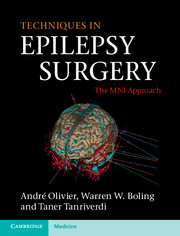Book contents
- Frontmatter
- Contents
- Acknowledgment
- Preface
- 1 History of epilepsy surgery
- 2 The search for the epileptic focus: investigation of the surgical candidate
- 3 Surgical anatomy
- 4 Neuronavigation and preoperative brain mapping
- 5 Stereoelectroencephalography (stereotactic intracranial recording)
- 6 Anesthesia and awake procedure
- 7 Peroperative brain mapping
- 8 Endopial resection (intervascular endopial gyral emptying)
- 9 Surgery of temporal lobe epilepsy: cortico-amygdalohippocampectomy
- 10 Surgery of temporal lobe epilepsy: transcortical selective amygdalohippocampectomy
- 11 Surgery of central area epilepsy
- 12 Surgery of frontal lobe epilepsy
- 13 Surgery of parietal lobe epilepsy
- 14 Surgery of insular lobe epilepsy
- 15 Surgery of occipital lobe epilepsy
- 16 Hemispherectomy
- 17 Callosotomy
- 18 Epilepsy and brain tumors
- 19 Surgical treatment of cortical dysplasias
- 20 Reoperations in failed epilepsy surgery
- 21 Alternative procedures in surgery for epilepsy
- 22 Complications of epilepsy surgery
- 23 Quality of life after epilepsy surgery
- Index
- References
13 - Surgery of parietal lobe epilepsy
Published online by Cambridge University Press: 05 October 2012
- Frontmatter
- Contents
- Acknowledgment
- Preface
- 1 History of epilepsy surgery
- 2 The search for the epileptic focus: investigation of the surgical candidate
- 3 Surgical anatomy
- 4 Neuronavigation and preoperative brain mapping
- 5 Stereoelectroencephalography (stereotactic intracranial recording)
- 6 Anesthesia and awake procedure
- 7 Peroperative brain mapping
- 8 Endopial resection (intervascular endopial gyral emptying)
- 9 Surgery of temporal lobe epilepsy: cortico-amygdalohippocampectomy
- 10 Surgery of temporal lobe epilepsy: transcortical selective amygdalohippocampectomy
- 11 Surgery of central area epilepsy
- 12 Surgery of frontal lobe epilepsy
- 13 Surgery of parietal lobe epilepsy
- 14 Surgery of insular lobe epilepsy
- 15 Surgery of occipital lobe epilepsy
- 16 Hemispherectomy
- 17 Callosotomy
- 18 Epilepsy and brain tumors
- 19 Surgical treatment of cortical dysplasias
- 20 Reoperations in failed epilepsy surgery
- 21 Alternative procedures in surgery for epilepsy
- 22 Complications of epilepsy surgery
- 23 Quality of life after epilepsy surgery
- Index
- References
Summary
Introduction
There are many obstacles encountered in the pursuit to obtain excellent surgical results in parietal lobe epilepsy. Some of the most formidable difficulties are interpreting the semiology, absence of a visible lesion on imaging, the presence of highly eloquent cortical areas, bypassing visual fibers in the vicinity of the resection zone, and the intricacies of the surgical anatomy including its vascular components. However, the discovery of more discrete lesions with high-resolution MRI as well as the ability to navigate with pre- and peroperative functional mapping of sensory, motor, and speech functions has been particularly helpful in overcoming some of the obstacles in parietal lobe surgery.
The approach taken in this chapter is to consider the parietal lobe proper as well as some aspects of the central area because of the close anatomical and functional relationships. It is indeed impossible to discuss surgery of the parietal lobe without consideration of the central area and in particular the postcentral gyrus. Few series have been published on the surgical treatment of parietal lobe epilepsy and even fewer on the modern surgical and technical aspects. After a brief historical overview, a summary of the surgical anatomy of the parietal lobes is presented. The clinical manifestations of parietal epilepsy that are so crucial in establishing the hypothesis of the site of seizure onset are then presented from a practical surgical perspective. The technical aspects and various modalities of resections pertaining to the parietal lobe are addressed. Finally, an analysis of several representative cases is presented with stress on the operative approaches, findings, and results.
- Type
- Chapter
- Information
- Techniques in Epilepsy SurgeryThe MNI Approach, pp. 164 - 177Publisher: Cambridge University PressPrint publication year: 2012



